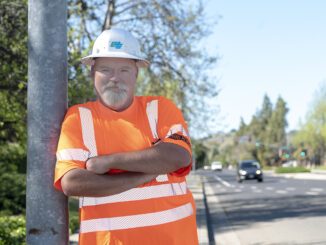
by Matt Jocks
When that long countdown to the end of a prison sentence reaches zero, the door swings open. It will mean little, however, if that’s the last open door an inmate sees.
Unlocking the entrance to the job market is essential for the 35,000 or more individuals released from California prisons yearly. It’s also essential for the economy and for communities who feel the impact when those who are released fail to find solid employment and reoffend.
The Mother Lode Workforce Development Board, serving four counties straddling Central and Northern California, has taken an aggressive and innovative approach in leading former prisoners to those open doors.
Inside, Mother Lode has facilitated training and certification programs, as well as counseling. In a significant advance, it has opened job centers in the two prisons within their area, linked online to the CalJOBS site.
Mother Lode WDB also provided a lifeline to those on the outside, using grant money to offer training and certification.
While jobs, sustainable incomes and lowering the recidivism rate are all vital, the results of these programs are larger than those elements.
“It’s too simple to say we help them get a job,” says Dave Thoeny, executive director of Mother Lode WDB. “When we hear from people who have gone through, it’s never, ‘Thanks for helping me get a job.’ It’s ‘Thanks for changing my life, for giving me a reason to get up in the morning.’ ”
Eric Kile, one of the success stories of the post-release grant program, can attest to the transformation he underwent.
Kile battled drug dependency before and after his incarceration. He also had to fight through the self-doubt and lack of direction that comes with being in prison.
“You know, I probably didn’t have big plans to be a part of society,” he says. “I just wanted to get on with my life.”
After a couple of failed attempts at drug rehab, “it just clicked” on the fourth try, putting Kile in a position to find some direction. His job at a restaurant fell victim to COVID, but through a friend, he connected with the P2E (Prison to Employment) program.
A long-standing interest in the water treatment field was a perfect match for one of the available programs. In completing the academic portion and moving to work in the field, Kile found the kind of stability and trust that had been lacking in his life.
Kile credits the Mother Lode staff with helping him build a resume, polish his interview skills and navigate the application process.
“Never before had I really let a process work for me without putting myself in the way of it,” Kile says.
Along the way, he came to realize that his criminal record was less of an issue in the workplace than he had envisioned.
“The employers we have worked with have found ex-offenders to be good workers,” Thoeny says. “They’re motivated because they don’t want to reoffend. They’ve lived that life and they don’t ever want to live it again.”
The training in hard skills—specific job training as well as resume building—is central to the program. Linking to the CalJOBS database also gives job seekers coming from the justice system more equal footing with those outside.
Dave Thoeny, executive director of Mother Lode WDB
“It’s too simple to say we help them get a job. When we hear from people who have gone through, it’s never, ‘Thanks for helping me get a job.’ It’s ‘Thanks for changing my life, for giving me a reason to get up in the morning.’ ”
For some, the skill needs are even more basic. Many are disconnected from the changes in technology that have taken place while they were inside.
Amy Frost, deputy director of training for Mother Lode, tells of one man released at 30, after being locked up at 16, who sat on a curb and cried because he realized he had been released into a different world.
“He didn’t know anything about cell phones,” Frost says. “As a 30-year-old, he had to learn how to navigate this new world.”
In addition to those kinds of details, the Mother Lode programs also address soft skills—how to get past your own barriers and how.
“Many times, the biggest barriers are in the mind,” Frost says. “Low self-esteem, shame. They translate in their actions to where they sometimes shoot themselves in the foot before they can make a positive engagement.”
Frost says cognitive therapy is part of the process. It’s also a matter of teaching social skills—learning to be comfortable making eye contact and losing the defensiveness that has become ingrained through their previous life and during incarceration.
“Many of the survival skills they have adopted,” she says, “are things that can hurt them in trying to function outside.”
By necessity, the Mother Lode WDB has formed a long-distance partnership with workforce boards throughout the state. In California, most of the major prisons are in rural areas, but since offenders are released to the areas in which the crimes were committed, most head for heavily populated locations.
Gregg Irish, executive director of the Los Angeles City Workforce Development Board, has become “a big fan” of the Mother Lode board because his city has reaped the benefits of its work.
“What Dave and the others there do is sort of like triage,” Irish says. “They are the ones who touch those people first. He can do the things that get people ready to be successful when they come here. And that saves us time and money and effort.”
For someone like Kile, the stakes are even higher.
“What they did is help me get past that pre-conceived notion of my own limitations,” he says. “I’m really happy with where I am.”
For more information on the Mother Lode WDB, visit https://www.mljt.org/wdb. For more information on other state WDBs, see https:



